"How old is my La Pavoni?"
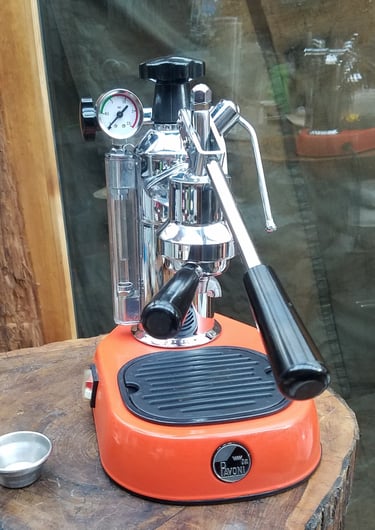

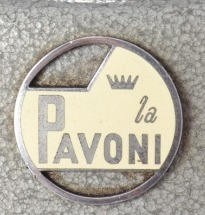

Guide To Dating La Pavoni Europiccola and Professional Lever Espresso Machines
The La Pavoni Europiccola wasn't the first home lever machine. The Gaggia "Gilda" (like the one we sold here) cobbled together in late '40s Post War Italy seems to have that honor, and Faema had been selling the home sized lever "Faemina" since the early 50s. In fact, even though Pavoni was a large maker of commercial espresso machines, they didn't even design the Europiccola themselves! They bought rights to make it from a small manufacturer in Milan, which had been struggling to sell the little machines for a couple years!
But when Pavoni put their name and marketing heft behind it, the Europiccola was suddenly on a path to dominate the world's "domestic" lever espresso machine market. La Pavoni went on to sell so many of these sexy Italian beasts, especially here in the US, over the next four decades, that the Europiccola virtually became synonymous with the home lever espresso machine.
Even with James Bond.
Pavoni's crazy success in the US market spawned many (mostly Italian) competitors in the 60s and 70s, with some companies shamelessly trying to knock off the Europiccola design, while others were actually licensed by La Pavoni to re-badge Europiccolas, and sell them as their own.
None ever succeeded in knocking Pavoni off the mountain top (even though it's fairly easy to make arguments that there were always "better" levers out there, or that build quality has declined over the years with successive corporate takeovers.)
So it's no surprise many people see La Pavoni as the obvious choice when mulling over vintage lever espresso machine options. Especially since they somehow still look as "modern" as they did exiting the factory over a half century ago!
Thousands of Pavoni "leverheads" with decades old machines still pull shots around the world every morning. And the intensity of the cult means vintage ones often sell for much more than they cost new!
The Europiccola has transcended mere "kitchen appliance," to become an icon. A "Classic" of 20th Century design. And as often noted, it's even in the NY MOMA permanent collection.
But La Pavoni sold so many machines over the years, with so few design changes to the casual observer, that like a VW bug, it can be a challenge figuring out what year you're looking at. The average person can be forgiven for seeing a dusty Europiccola at an estate sale, or blurry pic on ebay, and have no idea if it's a 1968, or 2008.
Some of the later machines have stickers with the production date on the underside of the metal base (under the plastic sub-base) but early models were usually unmarked. Sometimes you can find dates written in felt pen. But most often a few cryptic numbers stamped into the heating element are the only clue (usually correlating with the production year of the machine, but it's not unusual for an element to have been replaced, or even made the previous year .)
It could even be a "Frankenstein" machine (not that there's anything necessarily wrong with that!) of cobbled together new and used parts from different years, like a 1986 boiler on 2014 base, with a 1999 switch. What's so cool about Pavonis is that you can do stuff like that if you want to!
That ability to repair and retrofit new parts on older machines, and the build quality of the early La Pavoni components, has a lot to do with keeping the mystique of La Pavoni levers alive. All but the very earliest models remain "re-workable," with most parts and plenty of support readily available, even in the US.
Despite this, it's been notoriously difficult to find comprehensive or accurate lists of machine changes over the years. At least in one place. Maybe it's a problem with translation from Italian, or Pavoni is more interested in selling new machines than maintaining a history of their old ones. But La Pavoni owners, both recent and old school, seem to be constantly searching for (and arguing over) new info about their old machines.
This has led to some misconceptions, and "fake facts" being circulated on the internet by people who "heard it" from "somebody" (meaning they probably read something on the net, posted by somebody who read something on the net) rather than has first hand knowledge themselves. Even the coffee nerd sites can be full of conflicting "info," and sometimes inaccurate history by self appointed experts.
By all means hit the Google, because there are all kinds of websites with La Pavoni lore (and good info on other levers as well.) Just keep the old "telephone" game in mind, where a statement can completely change as it gets whispered from person to person. Just because you read it on the internet, doesn't mean it's "true."
So in a humble attempt to fill some of the Void, here's a quick "cheat sheet" for dating La Pavoni home levers, followed by a more detailed listing of the machine's evolution for hardcore Pavoni geeks. While by no means archival (send an email if you spot an error, or have a comment) web tried!
QUICK LA PAVONI MODEL "CHEAT SHEET"
GAUGE -- If it has a pressure gauge, it's probably a Professional model. No gauge, a Europiccola. (It IS possible to retrofit most Europiccolas with a gauge, and you will occasionally see one for sale here, but it's "not normal.")
BOILER -- The boiler is the "give away." A Europiccola boiler is about half the diameter of the fatter Professional boiler. (The Europiccola boiler is roughly the same diameter as the group, while the Professional boiler is about TWICE that size.) The Romantica models can have either size boiler, with the top cut "flat," and fitted a "fancy" dome.
"PRE-MILLENNIUM" MODELS -- Simply means La Pavoni lever machines made before 2001 (the title "Millennium," is a bit confusing because your 2000 La Pavoni may or may NOT be a "Millennium" model, even though is was made after the calender "millennium.") Pre-Millennium models are most easily recognized by the group (the thing your portafilter locks into) which has sharper edges on the shoulder, and a slightly smaller diameter than the Millennium.
In an attempt to reduce high brewing temperatures, La Pavoni re-designed the group for the model year 2001, and branded it the "Millennium" model (more about the re-designed group below.) The group was slightly "fatter," with softer curves on the shoulders.
EUROPICCOLA DATING "CHEAT SHEET" (using obvious component changes)
"La Pavoni" BASE BADGES: Silver metal circle, with white "la Pavoni" logo on white, early 1961
Pavoni "red sticker" 1961-1968
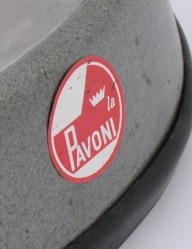

Red and White plastic logo, 1969-1978
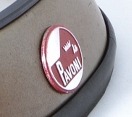

Black and silver logo, 1979-1992
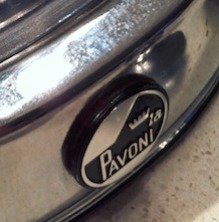

Recessed black and white logo, 1993+
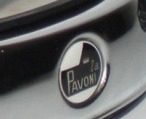

BASE:
Aluminum w/"hammertone" paint, with "shallow" drip tray, no cup "grid" 1961-1963
Aluminum "hammertone" paint, modern "deep" drip tray, aluminum "grid" 1964-1969
Aluminum "hammertone" paint, with chromed steel "grid" 1970-1974
Stamped steel, solid color painted, plastic drip tray insert appears under chrome "grid," 1975-1983
(Stampted steel base became available with chrome, brass and copper plating, 1978+)
Stamped steel, plastic "grille" replaces chrome grid, tray "screw hole" for plastic sub-base, 1984-2007\\\
Stamped steel, "screw hole" removed, plastic sub-base attaches from underneath 2007-present
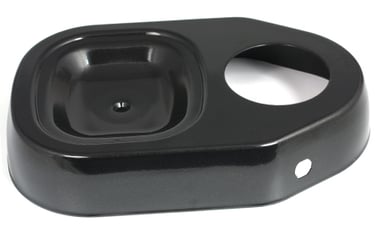

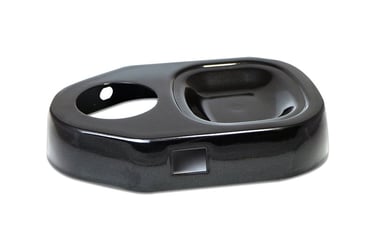

Sub base:
Blue rubber, early 1961
Black rubber, 1961-1984
Black ABS plastic, attaches with screw through drip tray, 1985-2007
Black ABS plastic, attaches underneath base, 2008+
Switch:
Metal "2-way" toggle, with "minimo/massimo" graphics highlighted in red, 1962-1973
Stamped steel base w/drip tray hole, 1984-2007
No hole stamped steel, 1976-1983
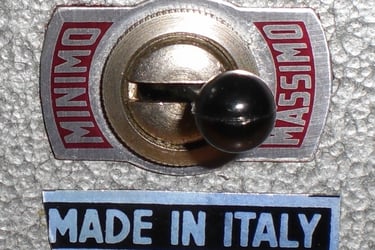

Metal surround with neon indicator light, and 3 way rocker. 1974-1977
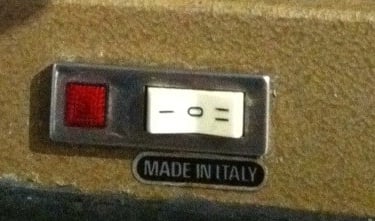

Red power light, white "hi/low" rocker, "Minimo/Massimo" on silver trim, 1978
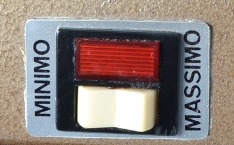

Red (power) white (hi/low) rocker, with "I" & "II" graphics, 1979-1991


Red/Green power switch, 1992 +
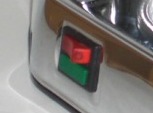

Professional Models
Sub Base:
Black rubber, 1975-1983
Black ABS plastic, attaches with screw through drip tray, 1984-2007
Black ABS plastic, attaches from underneath drip tray, 2008+
Switch:
White plastic rocker switch, red "on/off" light, pre 1979
Red on/off switch, 1979-1997
Green on/off switch, 1998+
DETAILED MODEL CHANGES, EUROPICCOLA
1961 --
The initial Europiccola is characterized by a chromed brass boiler without a sight glass. The stamped aluminum base has a "shallow" drip tray indentation, without a "grid." The chrome plated brass group neck screws into the boiler, and the group itself had a brass sleeve screwed into it, with a brass piston installed, that requires a special tool to remove. The two position metal toggle switch controls a double ("high" 800 watts, and "low" 200 watts) heating element, screwed into the base of the boiler. The base has a "hammered silver" finish, with a blue rubber sub-base, and a handsome cast metal "la Pavoni" badge on the front. The 49mm portafilter tightens to the left (presumably to help right handed operators steady the machine when pushing.) #1-1100
1962 --
The sight glass arrives, with a chromed bolt on top. Black rubber sub-base. #1101-2500
1963 --
Top of the sight glass gets a chrome "shroud." #2501-5000
1964-68
Drip tray is stamped deeper, and aluminum grid added to cover it. #5001-A5000
1969-70
Flat top 12mm chrome screw replaces "shroud" on top of sight glass. #A5001-B0000
1971-73
Shower screen becomes removable. Tray grid becomes chromed steel. #B0001-35000
1974 --
Three way rocker switch finally allows machine to be turned off! #35001-51000
1975-77 "Second Generation"
The '75 model year brings big changes to the Europiccola. Often referred to "Generation/Version 2," the group bolted onto the boiler instead of screwing in, the brass cylinder insert removed, and piston dimension increased, making it easy to remove for servicing. The portafilter gasket changes. The boiler cap becomes all black plastic, and gets male threads, instead of female. The base is changed from aluminum to stamped steel. The black plastic drip tray insert appears under the chrome grid.
1978
On/off switch changes to "dual" one, with red "on/off" and white "high/low."
1979-83
'79 saw the heating element changes from screw in to bolt-on (on a carrier ring that screws into the boiler. The early screw in elements are no longer available! So don't run them dry! There were also AT LEAST two thread pitches on the carrier ring for the heating element. Make sure to confirm which version you have before ordering a new element in this late 70s early 80s era. Chrome bases become available, including some that were plated over brass or copper bases, and these saw problems with peeling chrome plating.
1984-90
Added thermal fuse, and new 4 prong heating element. Changed sub-base from rubber to plastic, and drilled the notorious "screw hole" through the drip tray (at low point where water collects) to fasten it, often worsening any rust or corrosion issues, and can allow water into electrical component area.
1991-92
Pressurestat finally added, which ended the need for "dual" switches and two heating elements, and allows single "on/off" switch (red) with green power light. Pressure set to .8-1 BAR at the factory. (Industry standard.) Plastic protector added over sight glass. Deluxe wood knobs and handles become available.
1993-96
Quick change removable steam arm (to facilitate dubious "frother" attachment) introduced.
Mostly chrome bases by now, but brass bases become brass. Plastic handle smooth instead of grooved.
1996-
Resettable overheat thermal fuse. (A nice replacement for the previous "blowable" kind.)
1997-00
"Hi-tech" polymer piston (polyphenylene shuphide) introduced (replacing brass) in effort to control brew heat in group. This new piston was not "cheap" but did have some issues with "unscrewing itself" from lever rod because of heat differential with poly and steel. The unscrewed pistons would eventually push off shower screen. The poly pistons can also crack or fracture from heat and pressure stress.
2001-07 Millennium Model
"Millennium" model comes out in 2001, with completely recast group. The "plastic" piston now gets a matching poly insert into the widened group cylinder, in further effort to reduce heat from boiler. (See pic of "Millennium" group above.) The bigger bore meant a wider portafilter (from 49 to 51mm wide) and new seal to go along with new wider baskets. Earlier "Pre-Millennium" La Pavoni portafilters will NOT fit in the later "Millennium" models.
2008+
Pavoni gives up on poly piston, and goes back to earlier brass one (but keeps the poly insert in the Millennium group.) They also mercifully get rid of screw hole in drip tray (after 24 years) and attach it from the bottom again. Cheers go up around the world.
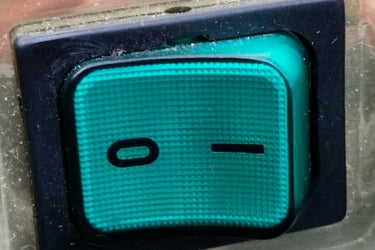



La Pavoni Variants
Ambassador - La Pavoni's US market only predecessor to the Professional. Basically the Europiccola (no gauge, dual switch elements) with the larger boiler that would become the Professional. Sold in America in the early 80s. But once the Professional was established, there really wasn't a need for this configuration, and it was phased out. If you come across a "Europiccola" with an odd large boiler, you're probably looking at an Ambassador. (Hat tip to La Pavoni aficionado Hank Bates!)
Gaggia - "Factory"
The two "versions" known as models 105, and 106, were the Millenium Europiccola and Professional respectively, with "flat tops" (the Romantica.) Gaggia slapped their own pointy "dunce cap" top (more charitably known by some Factory owners as "the Tin Man") and a cheesy "Factory" logo where the Pavoni badge normally resides, and sold them re-branded as Gaggias starting in the late 90s. No longer sold. A bit pathetic for the company the INVENTED the home lever machine, but since they seem to have been targeted mainly at the US market as discounted La Pavonis, Gaggia apparently decided the reward to their bottom line was worth the risk to their prestige. Gaggia is obviously not the same company it once was.
MARCFI -- "La Cara," or the "La Graziella" and/or "Picola"
MARCFI was a Spanish company, originally licensed by La Pavoni to make the Europiccola in the mid 60s, under the Franco dictatorship. After a dispute, Pavoni ended the license agreement, but MARCFI continued making "Spanish Pavonis," daring the Italians to sue them in the Fascist Spanish court system. Pavoni apparently decided not to bother, and MARCFI went on making "Pavoni" espresso machines in Spain for years. La Pavoni managed to keep them from exporting out of Spain for the most part, but some found their way into the US via the enterprising La Pavoni dealer in San Francisco, Thomas Cara, Ltd. Cara put his own label on them, until being legally stopped by La Pavoni in around 1980. The Graziella had a large handsome boiler with a stepped top, on a Pavoni style base. The early base was dark gray, the later ones all chrome. The group is basically a Pre-Mellenium La Pavoni with a different bolt on flange. Heating elements are impossible to source new now.
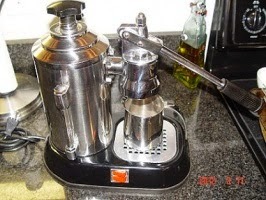


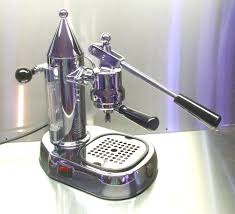
Romantica - La Pavoni "updates" the look of the Europiccola in mid 90s, and Professional in mids 2000s, by cutting off the top (flat top) and adding a "fancy" removable dome top (sometimes with an eagle) and wood handles. The Pre-Millennium and Millenium group changes were the same.
Stradivari - Yet another La Pavoni effort at "modernizing the look" of the Europiccola, with a redesigned sleeker group, a "figure 8" shaped base, and a "bow" shaped lever (get it? the violin reference.) Launched about 2005. Ho hum. Not sure why anyone would ever buy one of these over the classic Pavoni lever design, but maybe you're a 22 year old dot com millionaire with no sense of history or style.
Zabar's -- Piccola and Grande
Housewares/deli in NYC rebranded and sold Pavoni machines for many years. The Europiccola became the "Piccola," and the Professional became the "Carina Grande." They have been allowed to sell the re-branded machines for prices higher or lower than same machines at regular dealers, but they are all made by La Pavoni in Italy. (Maybe somebody at Zabar's had a Pavoni reletive in Italy?!) There are rumors that some of the re-branded Zabar's machines may actually have a cheaper base.
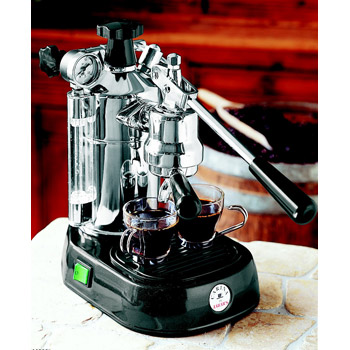

Zabar's Carina Grande
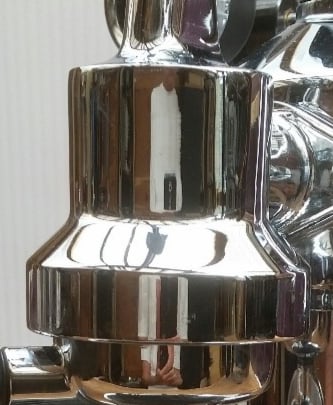

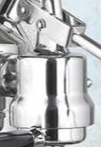

Vintage and Custom Espresso Gear Bought and Sold, Restorations, Repairs
© 2025. All rights reserved.
The Mission
San Francisco
415-404-1377
dan@leverunderground.com